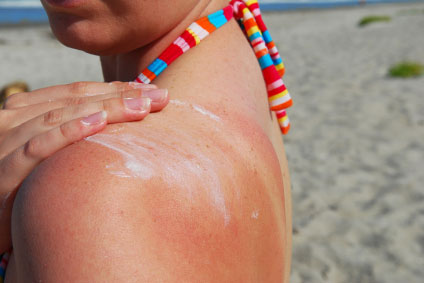It’s a spot of bad news in an otherwise hopeful update on cancer in Canada.
Skin cancer, one of the most preventable forms of the disease, is also one of the fastest-rising in this country, according to a new report from the Canadian Cancer Society that notes the death rate for all cancers combined continues to fall for most age groups.
Skin cancer, including melanoma, is one of the most preventable types of cancer. The main risk factor is UV radiation from overexposure to the sun and other sources, such as indoor tanning beds. UV radiation causes about 90% of melanoma cases.
“It’s important to draw attention to the rising incidence and death rates for skin cancer so that we can look at ways to be more effective in tackling this important public health problem,” says Dr Prithwish De, Epidemiologist, Canadian Cancer Society. “Skin cancer is a largely preventable disease if Canadians use proper sun protection and do not use indoor tanning.”
Skin cancer is the most common cancer in Canada, with an estimated 6,500 new cases of malignant melanoma and another 76,100 cases of non-melanoma skin cancers expected to be diagnosed in 2014. Melanoma is the deadliest form of skin cancer, with 1,050 Canadians expected to die from it this year.
While the rate of new cases (incidence) and death rate for many types of cancer are going down in Canada (all rates are adjusted for age), for melanoma the story is less positive. According to the current report, which examined melanoma rates since 1986, melanoma has been increasing significantly in both men and women.
Risk factors
The main risk for skin cancer is UV radiation through exposure to the sun or from other sources, such as indoor tanning equipment.
Two national surveys of Canadians’ sun exposure and protective behaviours conducted over the past 2 decades show that Canadians are spending more time in the sun without adequate protection.
The proportion of adults who spent 2 or more hours in the summer sun on a typical summer day during their leisure time increased from 1996 to 2006, and they were more likely to spend at least 2 hours in the sun while on vacation. Despite this increase in sun exposure, there was no corresponding increase in the proportion of adults using any of the recommended forms of sun protection. In fact, significantly fewer Canadians reported wearing protective clothing and hats in 2006 compared to the decade earlier. As well, fewer adults reported hearing about or seeing the UV index, a key tool to help plan sun-protective actions.
“We are concerned that Canadians are spending more time in the sun without proper protection,” says Dr Robert Nuttall, Director, Cancer Control Policy, Canadian Cancer Society. “The survey results remind us of the important role that health organizations, including the Canadian Cancer Society, have to play in encouraging Canadians to protect themselves from UV radiation.”
Tanning beds are high-output UV machines that deliver intense doses of radiation designed to produce rapid and deeply coloured tans. The amount of radiation emitted has been documented to be many times more than natural sun at midday in summer. The World Health Organization classifies tanning beds as a known factor that causes cancer in humans. According to research, people who first started using indoor tanning equipment before the age of 35 have a 59% increased risk of melanoma.
A lot of intermittent, intense UV exposure, especially during childhood, increases the risk of melanoma. People with fair skin (especially skin that burns easily and tans poorly), red hair or multiple or atypical moles have at least double the risk for melanoma. It is estimated that children and adolescents who get 5 or more sunburns have double the risk for melanoma later in life. A family history of melanoma, which means having a first-degree relative (parent, sibling or child) with melanoma, is associated with a 2- to 4-fold increase in the risk of melanoma. Having a prior diagnosis of melanoma or non-melanoma skin cancer increases the risk of a subsequent melanoma diagnosis.
Prevention
“The good news is that there are simple ways to protect yourself against UV radiation,” says Dr Nuttall. Some of the ways are:
Plan outdoor activities before 11 a.m. and after 4 p.m., when the sun is not at its strongest, or any time of the day when the UV Index is 3 or less.
Seek shade.
Wear protective clothing, broad-brimmed hats and sunglasses.
Use sunscreen properly – apply to all parts of the body that are not covered by clothing.
Don’t use indoor tanning.
Economic cost of skin cancers in Canada
According to the most recent estimates,* the economic burden of skin cancer in Canada was $532 million per year. Of that $532 million, 83.4% was attributable to melanoma and the remainder to the 2 major types of non-melanoma skin cancer – 9.1% to basal cell carcinoma (BCC) and 7.5% to squamous cell carcinoma (SCC). It was estimated that the economic burden of skin cancer would rise to $922 million annually by 2031, with BCC and SCC accounting for an increasing proportion of costs.
Trends in melanoma incidence and death
Melanoma skin cancer accounts for about 3% of all new cancer cases. While melanoma is the deadliest form of skin cancer, it represents only about 1.4% of all cancer deaths because of the good prognosis resulting from early detection.
The incidence rate of melanoma has increased significantly among men and women in Canada over the past 25 years. The death rate is also rising, representing the second greatest increase after liver cancer deaths in men and lung cancer in women.
One in 59 Canadian men will develop melanoma in his lifetime, and 1 in 240 will die from it. In men, the incidence rate increased 2% per year between 1986 and 2010, from 9 to 15 cases per 100,000. The death rate has increased by 1.2% per year.
One in 73 Canadian women will develop melanoma in her lifetime, and 1 in 395 will die from it. In women, the incidence rate increased 1.5% per year between 1986 and 2010, from 8 to 12 cases per 100,000. The death rate increased by 0.4% per year.
Non-melanoma skin cancer (NMSC)
NMSC represents at least 30% of all new cancer cases in Canada, but good estimates of the true burden of this type of cancer are not available because, unlike melanoma, it is not routinely reported as part of cancer surveillance. There are 2 subtypes of NMSC – about 80% of NMSC is basal cell carcinoma (BCC) and 20% is squamous cell carcinoma (SCC). BCC is usually slow growing, whereas SCC tends to be more aggressive and can spread to other parts of the body. The risk factors and ways to prevent it are the same as for melanoma.
Recommendations from the report
To lower the rising rates of new skin cancer cases and deaths, it is important for Canadians to:
practise sun safety
not use indoor tanning beds
A long-term commitment to skin cancer prevention is needed so that fewer Canadians are diagnosed with this type of cancer and more survive.
General highlights – Canadian Cancer Statistics 2014
Cancer continues to be the leading cause of death in Canada.
Over the past 30 years, the death rate for all cancers combined has been declining for men and women in most age groups.
There were no significant increases in death rates during the past decade for most types of cancer in men and women, with the exception of liver cancer in both sexes and lung cancer in women.
The 5-year relative survival rate for all cancers combined in 2006-2008 was 63%, an improvement over the survival rate of 56% in 1992-1994.
An estimated 191,300 new cases of cancer (which does not include 76,100 cases of non-melanoma skin cancer) and 76,600 deaths from cancer are expected to occur in Canada in 2014.
Rates of the disease are generally stabilizing for new cases and declining for deaths. However, the number of new cancer cases and cancer deaths continues to rise as the Canadian population grows and ages. Four types of cancer – lung, breast, colorectal and prostate – account for 52% of newly diagnosed cancers.
“Cancer, in all its forms, has touched many of us in one way or another. With the help of our partners, we are encouraging Canadians to embrace healthier lifestyles,” says Minister of Health Rona Ambrose. “As individuals, we must do what we can to protect ourselves, by covering up from the sun, eating well, being physically active and not smoking.”
Canadajournal/Press Releases
 Canada Journal – News of the World Articles and videos to bring you the biggest Canadian news stories from across the country every day
Canada Journal – News of the World Articles and videos to bring you the biggest Canadian news stories from across the country every day



